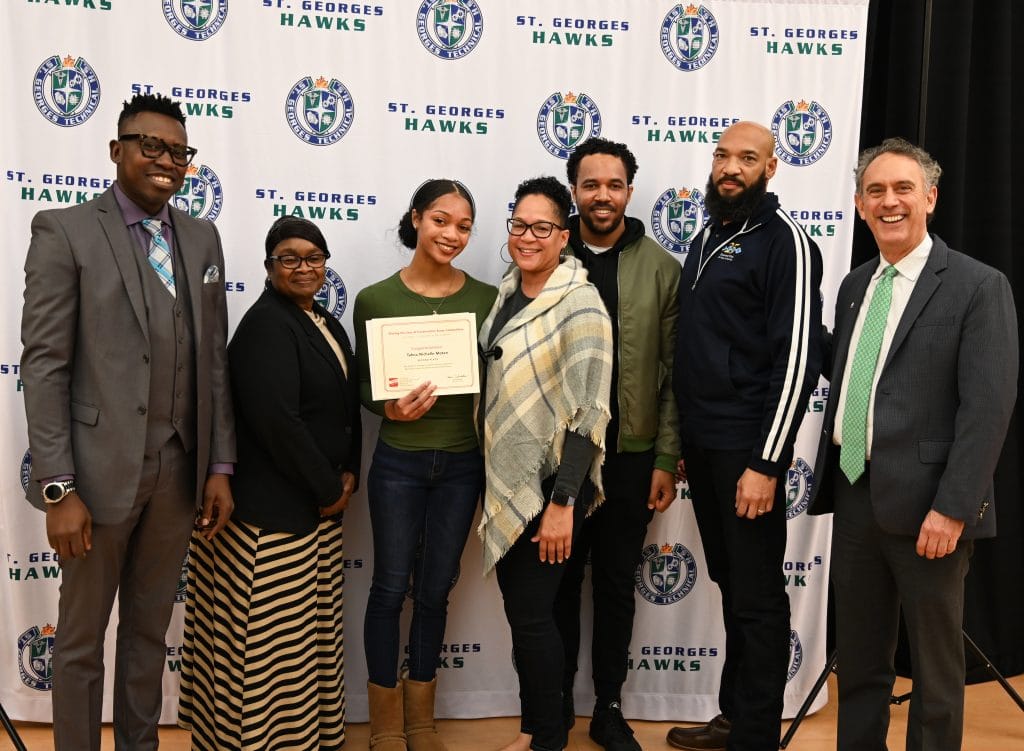The Sharing the Joys of Construction Essay Competition was created by EDiS Company in 2021 for Delaware trade and vocational high school students to shine a spotlight on the positive impact diversity has in the architecture, engineering, and construction (AEC) industry. Students wrote about individuals or companies who have inspired them or have had a positive impact on the built environment. First place winner Musulyn Fahnbulleh won a $700 prize, second place winner Tahna Moten won $500, third place winner Tyler Keyek won $300, and honorable mention Tianie Dixon won $100. Tahna would like to thank everyone who was in attendance and EDiS for the opportunity. Tahna plans to pursue classical writing in college.

Grade: 12th School: St. Georges Technical High School
A bright sun beams on the backs of hundreds of strong, courageous black warriors. Day in and day out they are working ferociously to complete whatever task is set for them to do. Centuries later, their legacy is kept alive- they are still honored. After all this time, their derived generations have crossed milestones and breakthroughs in a world that did everything in its power to keep them from doing so. Even still, outstanding ideas became real-life inventions, records were beaten and chains were broken. From ancient pyramids to the building of America, Black people have grown and created a hard-working industry that will forever prosper. The ancestors knew of all the power they possessed in which would pass down to their procreation, they knew all along.
Following the Civil War, improved communication and national currency was established. Leading to the shift of the American Industrial Revolution, the population increased by about 36 million people due to the arrival of immigrants. By this time, people were working in more diverse environments as opposed to just farmlands for wages. Although African-Americans are not credited for much of anything during the Industrialization, they were indeed very much prevalent. “Industrialization was considered a pecuniary European or Western Innovation that owed little to the rest of the world” (Trotter, 2000, para.7). Slaves were in control of handling iron as well as cutting and stacking wood. By the early 19th century, however, European immigrants began to do the same but were favored over those slaves. Paying wages to white immigrants seemed to be more convenient since the price of maintaining slaves grew.
During the Industrial Revolution, about twenty-five percent of all African-American farm families owned and operated their own land. Many photographs show these individuals working at important commodities supplying American needs during the eighteen and nineteen hundreds (Ford, 2020). The Black community began some of the biggest improvements in technology and agriculture and it is pivotal that be acknowledged. Ultimately, America relied on the crafts learned by Black people during slavery and so forth passed it along from generation to generation. “The African-American influence on the industrial revolution was in the form of labor” (nprs.gov, n.d, para.7).
Philip B. Downing, Lewis Howard Latimer, and Granville Woods were only three of the many black inventors throughout this time period. Philip B. Downing, native to Rhode Island and born in the year 1857, designed a street letterbox that would make communication through mail much more efficient than it had ever been. Before, papers intended to travel through the mail were at risk of being damaged by raw weather conditions. Not only that, but individuals no longer had to arrive at a post office to drop off or deliver mail. Farther north in the nation resided a man named Lewis Howard Latimer born in 1848. He was a very smart and skilled inventor who created an evaporative air conditioner, a toilet for railroad cars, and assisted in advancements of the light-bulb. Latimer was involved in a very critical role that contributed to the improvement of manufacturing. Granville Woods, the first African-American engineer and mechanic, aided in the development of street cars and trains. Woods established his own electrical company, manufactured electric railways and made successful communication on moving trains possible.
These are some of the many African-American inventors who, during the Industrial era, improved the economy immensely. They assisted in improving the health and security of the nation. Over time, many publishers have managed to construct an image that the Black community was not present in the building of the Industrial Revolution, but that is simply not true. Black contribution to not only America but the entire world is so important because it is inspirational and sets an amazing example. And furthermore, every achievement is deserving of a celebration and remembrance. Black innovators elevated the innovative eras throughout America with the birth of major advances in agriculture, transportation, communications, and electricity (Brookings edu., n.d, para.1). Construction in the hands of the African-American community has taken place even during ancient times. It has ultimately contributed to urban development, program management, and designing. Black people conquer each and every blockage and it empowers generations after them. Construction organizations are a result of an ongoing black legacy that has done so much for this nation and will continue to do so for eternity.




